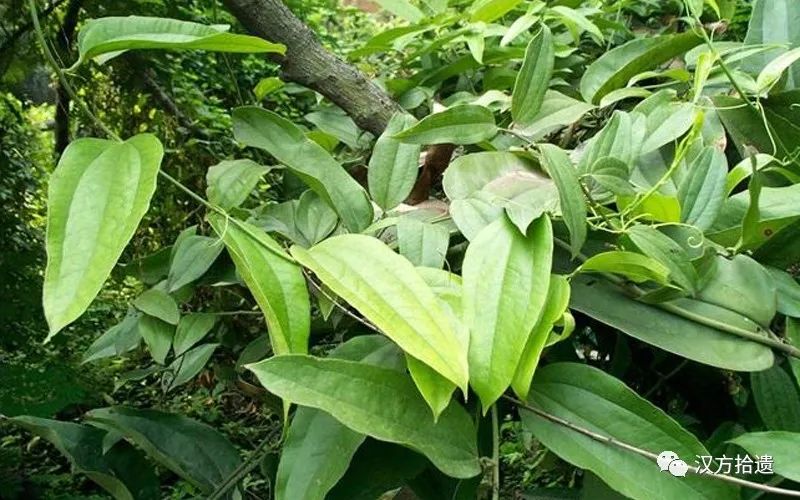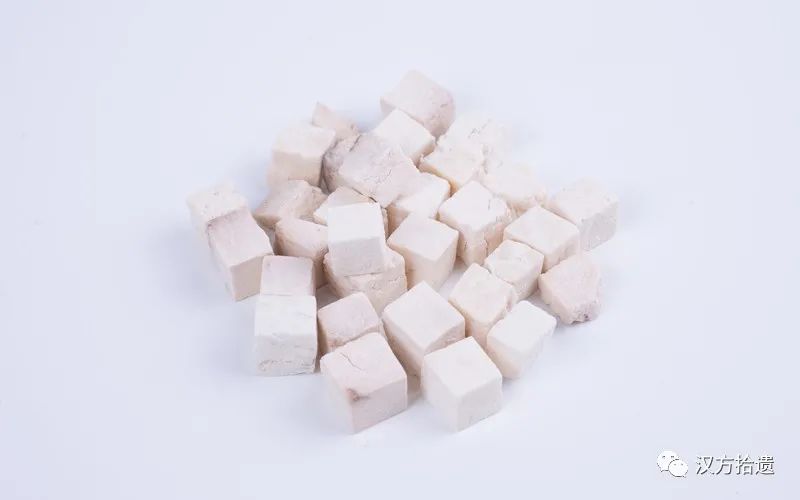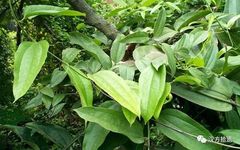“Fu Ling, a name in traditional Chinese medicine. Also known as: Fu Tu, Song Yu, Bu Si Mian, Song Shu, Song Ling, Song Mu Shu. It is the dried sclerotium of the fungus Poria cocos (Schw.) Wolf, belonging to the family Polyporaceae. The variety produced in Yunnan is called “Yun Ling” and is of superior quality. It has the effects of promoting urination and reducing edema, leaching dampness, strengthening the spleen, and calming the mind. It is primarily used to treat edema, phlegm retention, spleen deficiency diarrhea, palpitations, and insomnia.”
Properties and Channels
Sweet, bland in flavor; neutral in nature; enters the Heart, Lung, Spleen, and Kidney channels.

01
—
Functions and Actions
Functions
Promotes urination and reduces edema, leaches dampness, strengthens the spleen, and calms the mind.
Indications
1. Mainly used for edema, phlegm retention, spleen deficiency diarrhea, palpitations, and insomnia.
2. Western medicine diagnoses include heart failure, hypertensive heart disease, mitral stenosis, acute and subacute endocarditis, chronic pulmonary heart disease, and insomnia due to heart and spleen deficiency; acute glomerulonephritis, nephrotic syndrome, chronic renal failure, and chronic diarrhea due to spleen deficiency with excess dampness.
Dosage and Administration
Internal use: decoction, 10-15g; or in pills or powders. For calming the mind, mix with Zhu Sha (Cinnabar).
Contraindications
1. Contraindications in traditional Chinese medicine: avoid Bai Lian (White Peony); avoid Di Yu (Sanguisorba), Qin Jiao (Gentiana), Gui Jia (Tortoise Shell), Xiong Huang (Realgar); Fu Ling is used as an adjunct.
2. Dietary contraindications: avoid vinegar and acidic foods; avoid scallions.
Precautions
Use with caution in cases of yin deficiency without damp-heat, deficiency-cold with slippery essence, and qi deficiency with sinking.
Chemical Composition
This product contains β-Fu Ling polysaccharides, accounting for about 93% of the dry weight, and also contains Fu Ling acid, proteins, fats, lecithin, choline, histidine, and ergosterol.
Pharmacological Effects
1. Effects on the digestive system: Fu Ling has a direct relaxing effect on the isolated intestinal segments of rabbits. It inhibits gastric ulcers caused by pyloric ligation in rats and can reduce gastric juice secretion and free acid content. Fu Ling has a protective effect on liver damage caused by carbon tetrachloride in rats, significantly reducing alanine aminotransferase activity and preventing hepatocyte necrosis.
2. Effects on the cardiovascular system: Fu Ling water, ethanol, and ether extracts can enhance myocardial contractility and increase heart rate in experimental animals. Fu Ling polysaccharides can inhibit capillary permeability and increase myocardial Rb uptake in mice.
3. Effects on the central nervous system: Intraperitoneal injection of Fu Ling decoction significantly reduces spontaneous activity in mice and can counteract caffeine-induced hyperactivity. Fu Ling decoction shows a significant synergistic effect on the anesthetic action of pentobarbital sodium in mice. Fu Ling can enhance the central inhibitory effect of thiopental sodium on mice.
4. Effects on the urinary system: Fu Ling alcohol extract has a significant diuretic effect.
5. Effects on immune function: A compound containing Fu Ling (Dang Shen, Bai Zhu, Fu Ling) taken internally can significantly increase the rate of natural killer cell formation and the lymphocyte transformation rate induced by phytohemagglutinin, as well as significantly increase serum IgG levels, indicating its role in promoting cellular and humoral immunity.
6. Additionally, Fu Ling has functions such as lowering blood sugar, anti-tumor effects, anti-pathogenic microorganisms, and promoting hematopoietic function.
Related Discussions
1. “Shen Nong’s Herbal Classic”: Main treatment for chest and rib qi reversal, anxiety, fear, palpitations, pain under the heart, cold and heat, fullness, cough, dry mouth and tongue, and promotes urination. Long-term use calms the soul, nourishes the spirit, prevents hunger, and prolongs life.
2. “Shi Bu Zhai Medical Book”: Fu Ling is the main herb for treating phlegm, the root of phlegm is water, and Fu Ling can promote water movement. The movement of phlegm is dampness, and Fu Ling can also leach dampness.
02
—
Clinical Applications
Clinical Applications
1. Treats edema and urinary difficulties caused by internal dampness, often combined with Ze Xie (Alisma), Zhu Ling (Polyporus), Bai Zhu (Atractylodes), and Gui Zhi (Cinnamon Twig), such as in Wu Ling San (“Treatise on Febrile Diseases”).
2. Treats edema due to spleen and kidney yang deficiency, can be combined with Fu Zi (Aconite) and Sheng Jiang (Ginger), such as in Zhen Wu Tang (“Treatise on Febrile Diseases”).
3. Treats water-heat mutual accumulation and urinary difficulties due to yin deficiency, combined with Hua Shi (Talc), E Jiao (Donkey-hide Gelatin), and Ze Xie, such as in Zhu Ling Tang (“Treatise on Febrile Diseases”).
4. Treats dizziness and palpitations due to phlegm retention, combined with Gui Zhi, Bai Zhu, and Gan Cao (Licorice), such as in Ling Gui Zhu Gan Tang (“Essential Prescriptions from the Golden Cabinet”). If phlegm is retained in the stomach and causes vomiting, often combined with Ban Xia (Pinellia) and Sheng Jiang, such as in Xiao Ban Xia Jia Fu Ling Tang (“Essential Prescriptions from the Golden Cabinet”).
5. Treats diarrhea due to spleen deficiency with excess dampness, combined with Shan Yao (Chinese Yam), Bai Zhu, and Yi Yi Ren (Coix), such as in Shen Ling Bai Zhu San (“Formulas from the Bureau of Medicine”).
6. Treats weakness of the spleen and stomach, fatigue, poor appetite, and loose stools, combined with Ren Shen (Ginseng), Bai Zhu, and Gan Cao, such as in Si Jun Zi Tang (“Formulas from the Bureau of Medicine”).
7. Treats palpitations and insomnia due to deficiency of both heart and spleen, and insufficient qi and blood, often combined with Huang Qi (Astragalus), Dang Gui (Angelica), and Yuan Zhi (Polygala), such as in Gui Pi Tang (“Jisheng Fang”).
8. Treats heart qi deficiency, inability to contain the spirit, fear, and restlessness, often combined with Ren Shen, Long Chi (Dragon’s Tooth), and Yuan Zhi, such as in An Shen Ding Zhi Wan (“Medical Heart Insights”).
Related Combinations
1. Fu Ling combined with Ze Xie: Fu Ling is neutral, tonifying without being harsh, and diuretic without being forceful; it can both support the righteous and expel evil. Ze Xie is cold in nature, effective in promoting urination, leaching dampness, and clearing heat, good at draining the kidney’s fire and relieving bladder damp-heat. When used together, Ze Xie benefits from Fu Ling, promoting urination without harming spleen qi; Fu Ling benefits from Ze Xie, enhancing the power of diuresis and dampness elimination. Suitable for all conditions of dampness retention, such as edema, cloudy urine, urinary difficulties, and diarrhea.
2. Fu Ling combined with Zhu Ling: Fu Ling both tonifies and promotes urination; Zhu Ling has a stronger diuretic effect than Fu Ling but lacks tonifying properties. The two herbs complement each other, greatly enhancing the diuretic and damp-leaching effects, while also benefiting the righteous without harming it. Suitable for urinary difficulties and edema caused by internal dampness, diarrhea, and cloudy urine.
3. Fu Ling combined with Dang Shen: Fu Ling is sweet and bland, primarily promoting urination and leaching dampness, while also strengthening the spleen and assisting in transportation; Dang Shen is sweet and warm, best at tonifying the spleen and benefiting qi. The two herbs complement each other, greatly enhancing the effects of tonifying the spleen and benefiting qi. Suitable for weak spleen and stomach with poor appetite, loose stools, and fatigue; edema and urinary difficulties due to spleen deficiency with dampness retention.
4. Fu Ling combined with Huang Qi: Fu Ling is sweet and bland, with the ability to strengthen the spleen and promote urination and leaching dampness; Huang Qi is sweet and warm, good at tonifying qi and raising yang, strengthening the spleen, and promoting urination and reducing edema. The two herbs complement each other, enhancing the effects of tonifying the spleen, benefiting qi, promoting urination, and reducing edema. Suitable for weak spleen qi with poor appetite and fatigue; edema, leukorrhea, and increased vaginal discharge due to spleen deficiency.
5. Fu Ling combined with Suan Zao Ren (Sour Jujube Seed): Fu Ling is good at tonifying the heart and spleen and calming the spirit; Suan Zao Ren is good at nourishing the liver and calming the spirit. The combination of the two has the effect of tonifying the heart and spleen, nourishing blood, and calming the spirit. Suitable for palpitations, insomnia, forgetfulness, and poor appetite due to deficiency of both heart and spleen, and insufficient qi and blood.
6. Fu Ling combined with Bai Zhu: Fu Ling is good at leaching dampness and benefiting the spleen; Bai Zhu is good at strengthening the spleen and drying dampness. The combination of the two has a balanced effect of leaching dampness and benefiting the spleen, making it a harmonizing and tonifying agent. Suitable for symptoms of spleen deficiency with excess dampness, such as fatigue in the limbs, abdominal distension, poor appetite, diarrhea, edema, urinary difficulties, and leukorrhea due to spleen deficiency.
7. Fu Ling combined with Ban Xia: Ban Xia is good at drying dampness and transforming phlegm, harmonizing the stomach and descending counterflow, resolving fullness and dispersing masses; Fu Ling is good at strengthening the spleen and leaching dampness, and is tonifying without being greasy, diuretic without being harsh, able to support the righteous and expel evil. The combination of the two addresses counterflow and stops vomiting as a symptom, while strengthening the spleen and harmonizing the middle as the root cause, achieving the effects of strengthening the spleen, promoting urination, drying dampness, transforming phlegm, and harmonizing the stomach. Suitable for spleen deficiency with dampness retention, stomach qi not descending, symptoms of abdominal distension, belching, vomiting, and loose stools, or cough with excessive phlegm.
8. Fu Ling combined with Fu Zi: Fu Zi is pungent and hot, good at warming the kidney and assisting yang; Fu Ling is sweet and bland, good at strengthening the spleen and leaching dampness. The combination of the two warms the kidney and nourishes the earth, significantly enhancing the effects of strengthening the spleen and promoting urination and leaching dampness. Suitable for symptoms of spleen and kidney yang deficiency, internal dampness retention, such as floating limbs, urinary difficulties, and abdominal pain with diarrhea.
Distinguishing Medicinal Use
1. Fu Ling vs. Zhu Fu Ling: Raw Fu Ling can promote urination and leach dampness, strengthen the spleen, and calm the mind. It is used to treat edema, phlegm retention, heat strangury, diarrhea, vomiting, palpitations, and insomnia. Zhu Fu Ling, mixed with fine powder of Zhu Sha, has a stronger calming effect and is often used for insomnia, palpitations, and forgetfulness caused by unsettled spirit.
2. Fu Ling Pi (Fu Ling Skin), Chi Fu Ling (Red Poria), Bai Fu Ling (White Poria), and Fu Shen (Fu Ling Spirit): Different parts of Fu Ling have different effects. The black-brown outer skin of the sclerotium is used as Fu Ling Pi, with similar properties to Fu Ling, best for treating superficial edema and promoting urination. The red part beneath the skin is Chi Fu Ling, which enters the blood level and is good at clearing damp-heat. The white part inside the sclerotium is Bai Fu Ling, which enters the qi level and is good at strengthening the spleen and leaching dampness. Bai Fu Ling and Chi Fu Ling have similar properties and can be used for urinary difficulties, edema, phlegm retention, vomiting, diarrhea, nocturnal emissions, cloudy urine, palpitations, and forgetfulness. However, Bai Fu Ling is more tonifying, while Chi Fu Ling is more diuretic; Bai Fu Ling is preferred for tonifying the spleen and heart, while Chi Fu Ling is better for promoting urination and clearing damp-heat. The white part containing pine roots is called Fu Shen, also known as Bao Mu Shen, first mentioned in “The Classic of Famous Physicians”; its properties and effects are similar to Fu Ling, particularly good for calming the heart and spirit, often used for palpitations, forgetfulness, insomnia, and anxiety. The pine root within the sclerotium is called Fu Shen Mu, with a sweet and neutral nature, good for calming the liver and spirit, treating palpitations, forgetfulness, stroke, and leg cramps, especially suitable for cases of liver heat and internal wind.
Related Medicinal Products
Ling Gui Ke Chuan Ning Capsules, Xiao Er Zhi Xie An Granules,
Related Formulas
Wu Ling San (“Treatise on Febrile Diseases”), Ling Gui Zhu Gan Tang (“Essential Prescriptions from the Golden Cabinet”), Shen Ling Bai Zhu San (“Formulas from the Bureau of Medicine”), Gui Pi Tang (“Essential Prescriptions from the Golden Cabinet”).
Medicinal Cuisine
Fu Ling Red Bean and Job’s Tears Porridge:
1. Efficacy: Promotes urination and leaches dampness, strengthens the spleen, and stops diarrhea.
2. Ingredients: 20g of Bai Fu Ling powder, 50g of red beans, 10g of Job’s tears.
3. Method: Soak the red beans for half a day, then cook with Job’s tears to make porridge. After the red beans are soft, add Fu Ling powder and continue cooking until it becomes porridge.
4. Usage: Add a little white sugar and consume as desired.

03
—
Processing and Preparation
Harvesting and Processing
Harvested mainly from July to September. After digging, remove the soil and sand, pile them up to “sweat” for a while, then spread out to dry until the surface is dry, and then “sweat” again, repeating several times until wrinkles appear and most of the internal moisture is lost, then air dry, referred to as “Fu Ling Ge”. After soaking, slightly steam, and cut into slices, then dry; or cut fresh Fu Ling according to different parts and air dry for raw use.
Preparation Methods
1. Fu Ling: Take the original herb, separate by size, soak, wash clean, moisten thoroughly, slightly steam, then cut into thick slices or blocks while hot, and dry.
2. Zhu Fu Ling: Take Fu Ling slices and mix with a specified amount of fine Zhu Sha powder. For every 100kg of Fu Ling, use 2kg of Zhu Sha.
Storage Methods
Store in a dry container in a cool, dry place.
04
—
Identification of Medicinal Materials
Identification
1. The powder of this product is grayish-white. Irregular granules and branched clusters are colorless and gradually dissolve in water and chloroform. The mycelium is colorless or light brown, slender, slightly curved, branched, with a diameter of 3-8μm, some up to 16μm.
2. Take a small amount of this product powder, add one drop of potassium iodide solution, and it shows deep red.
3. Take 1g of this product powder, add 50ml of ether, treat with ultrasound for 10 minutes, filter, evaporate the filtrate, and dissolve the residue in 1ml of methanol to prepare the test solution. Take 1g of Fu Ling as a control and prepare the control solution in the same way. According to thin-layer chromatography (General Rule 0502), apply 2μl of each solution to the same silica gel G thin-layer plate, use toluene-ethyl acetate-formic acid (20:5:0.5) as the developing agent, develop, remove, dry, and spray with a mixed solution of 2% vanillin-sulfuric acid solution-ethanol (4:1), heat at 105°C until the spots are clearly visible. In the test solution, at the corresponding position of the control solution, the same color of the main spot appears.
Characteristics of Medicinal Materials
Complete Fu Ling is round, oval, flat, or irregular lumps of varying sizes. The outer skin is thin, brown or black-brown, rough, with wrinkles and constrictions, sometimes partially peeling off. It is solid, with a granular fracture surface, light red near the edge, with small honeycomb-like holes, and white inside, with some light red. Some contain pine roots, commonly referred to as “Fu Shen Kuai”. It has a faint odor, a bland taste, and is sticky when chewed. The best quality is firm in weight, with a brown outer skin, fine skin texture, no cracks, and a delicate white fracture surface that is sticky to the teeth.
Characteristics of Slices
1. Fu Ling: Irregular thick slices or blocks of varying sizes, with a white, light red, or light brown surface. Heavy, solid, with a granular cut surface. No odor, bland taste, and sticky when chewed.
2. Zhu Fu Ling: Shaped like Fu Ling slices, with a vermilion surface.
Common Adulterants
Adulterants:
Fu Shen: Formed naturally when pine roots grow through Fu Ling. In the market, one can see square wooden strips made from Fu Ling, paper pulp, and bark-less wood, pressed into a mold, white round cakes with a diameter of 4.5-6.5cm and a thickness of 1-2cm, filled with rectangular and various-sized pine wood blocks without bark.
05
—
Botanical Information
Plant Species
Fu Ling is a fungus of the genus Poria in the family Polyporaceae.
Morphological Characteristics
The sclerotium is spherical, oval, elliptical, or irregular, measuring 10-30cm or longer, with varying weights, generally weighing 500-5000g. The outer shell is thick and wrinkled, dark brown, soft when fresh, and hard when dry; the inside is white or light pink, granular. The fruiting body is flat on the surface of the sclerotium, 3-8cm thick, white, fleshy, turning light brown when old or dry. The pores are dense, 2-3mm long, with thin walls, and the pore openings are round, polygonal, or irregular, with a diameter of 0.5-1.5cm, often splitting into serrated edges. The spores are rectangular to nearly cylindrical, smooth, with a crooked tip, measuring (7.5-9)μm × (3-3.5)μm.
Distribution Areas
Distributed in Jilin, Zhejiang, Anhui, Fujian, Henan, Hubei, Guangxi, Sichuan, Guizhou, Yunnan, and Taiwan.
Production Areas
Mainly produced in Yunnan, Anhui, Hubei, Henan, and Sichuan. The variety from Yunnan is called “Yun Ling” and is of superior quality.
Growth Environment
Grows on the roots of pine trees.
Growth Observations
Fu Ling is a facultative parasitic fungus, growing wild at altitudes of 600-1000m in dry, sunny slopes of tree species such as Masson Pine, Huangshan Pine, Red Pine, Yunnan Pine, and Black Pine. Spores germinate at 22-28°C, mycelium grows at 18-35°C, and grows rapidly at 25-30°C. Fruiting bodies differentiate and grow at 18-26°C and can produce spores. The optimal moisture content for logs is 50%-60%, soil moisture content is 20%, pH 3-7, and sandy soil on slopes of 10°-35° is most suitable for growth. Conditions with large temperature differences between day and night are favorable for the growth of Fu Ling.
Reproductive Methods
Fu Ling can be cultivated using logs, tree stumps, and pine needles, but currently, log cultivation is predominant.
Cultivation Techniques
Select middle-aged pine trees with a diameter of 10-45cm, cut down, and peel the bark in intervals of 3-7cm, 3cm wide, penetrating 0.5cm into the wood, referred to as “peeling and leaving the fibers”. When the pine wood stops exuding resin and sounds hollow when tapped, saw the logs into 65-85cm long segments, and stack them in a ventilated, sunny place for later use. Choose a sheltered, sunny, slightly acidic sandy slope to dig a pit with a diameter of 90cm and a depth of 50-65cm, with a distance of 33cm between the upper and lower pits and 17cm between the left and right, and dig drainage ditches around. Take 3-5 logs of varying thickness, layer them in the pit. The inoculum, also known as the starter, can be mycelial, flesh, or wood inoculum, with mycelial inoculum being the most commonly used. Isolate pure strains from the sclerotium using PDA culture medium, with the cultivation medium containing 76% pine sawdust, 22% bran, and 1% each of gypsum and sugar, with a moisture content of 65%. After sterilization, inoculate with pure strains and cultivate for half a month at 25-28°C, then turn the bottles and cultivate for another half month at 22-24°C, which will yield mycelial inoculum. Flesh inoculum is obtained by harvesting fresh sclerotia one month before inoculation. Wood inoculum is made from logs without nodes, 4-10cm in diameter, cut into 50cm long segments, stacked in pairs, and fresh sclerotia of 250g are placed against the bark side of the logs, covered with 3cm of soil. After about 60 days, the mycelium can fill the logs. In early spring (March-April), inoculate using mycelial inoculum, preferably on sunny days, sharpen the fine logs in the pit, insert them into the cultivation bottles, and lean the coarse logs against the sides, covering with 3cm of soil. For flesh inoculum, cut the Fu Ling and place the flesh side against the upper end of the log’s cross-section or side, with the skin facing out. Wood inoculum can be cut into 5-6cm lengths, placed against the upper end of the log’s cross-section, or cut into two or three segments and placed in the middle of the log.


· Han Fang Shi Yi ·

Long press to identify the QR code to follow
Traditional Chinese medicine material information inquiry, promoting traditional Chinese medicine culture, welcome to subscribe for free!
▶丨About Us
Han Fang Shi Yi (zycorgcn) is a brand linked to Traditional Chinese Medicine Material Network (zyc.org.cn).Founded by Zhongzhai Media, it provides free inquiries about traditional Chinese medicine materials, shares classic works of traditional Chinese medicine, health culture, and information on the development of traditional Chinese medicine, promoting the essence of Chinese traditional medicine. Welcome to subscribe for free!
▶丨Copyright Statement
The copyright of the above text and images belongs to Han Fang Shi Yi (WeChat ID: zycorgcn), and any reproduction must retain this copyright statement.

